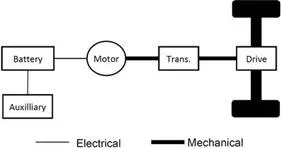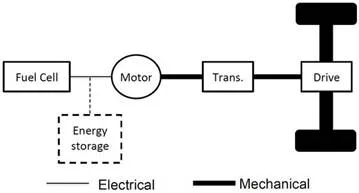Introduction to Development of Bus Drive Technology towards Zero Emissions: A Review
Over the past 100 years, the bus industry has come to be dominated by diesel powered buses due to their increasingly low cost and greater maturity of the technology. However, this comes at an environmental cost, for example, over 600 kt of CO2 was emitted by London’s bus fleet in 2015 [1]. It is these carbon emissions and their link to climate change that have provided one of the major drivers in recent years to develop and deploy alternative technologies for bus propulsion [2]. Other emissions associated with diesel vehicles such as NOx and particulates have provided a local driver to change due to their detrimental impacts on human health [3–5]. In 2008, it was estimated over 4000 deaths were brought forward as a result of long-term exposure to particulates in London [6]. In order to combat these concerns, many cities have introduced measures such as the ‘low emission zone’ in London and emission control targets [7]. London is to introduce the first ultra-low emissions zone (ULEZ) in 2020, which, amongst other targets will aim to replace conventional diesel powered buses with low emissions alternatives [8, 9]. Despite this drive for change, it is evident that finding a replacement for diesel buses is not simple. In addition to the low cost, simplicity, reliability and maturity of the technology, diesels also offer excellent characteristics to meet the required power demands and operational needs of city buses. It can be seen from Figure 1, the diesel engine that is a type of internal combustion engine (ICE) provides high output powers and uses energy dense fuel making them ideal for both the range and operating times expected of city buses and also for meeting the high transient power requirements during acceleration.

In order to address the environmental concerns posed by diesel buses, a number of technologies are being investigated and implemented. The most widespread of these are diesel-hybrid buses, which make use of an on-board energy storage system to effectively recycle captured kinetic energy obtained through regenerative braking. Although hybrid buses are capable of significantly reducing fuel consumption, they are still reliant on diesel as the primary fuel source and hence do not address the fundamental problems associated with emission that come from using diesel as a fuel. As such, there has in recent years been an increased focus on the development of zero emissions buses, with two main competing technologies. These are battery electric buses and hydrogen fuel cell (FC), both of which exhibit zero operating emissions, hence eliminates the environmental and health issues associated with diesel buses [11]. Such technology solutions are less mature and result in significant changes to the propulsion system. Although these technologies have been deployed in operational bus fleets, there remain a number of barriers to widespread deployment.
London has one of the most comprehensive and busiest public transport networks in the world, operated by Transport for London (TfL). There are over 9000 buses in operation [12], which are estimated to account for 21% of the CO2 emissions in London [7], 63% of NOx and 52% of PM10 particulate emissions [13]. It is reported that the TfL bus fleet carries 6 million passengers each working day, which the number of bus passenger journeys grew by 64% between 2000 and 2013 and is continuing to increase [14]. The Greater London Authority (GLA) has introduced a number of strategies in an attempt to reduce emissions from buses, part of which is the London hybrid bus project which aims to replace the conventional bus fleet with diesel hybrid buses [7, 15]. This is to be furthered with the introduction of the ultra-low emissions zone (ULEZ) in 2020, which, amongst other targets will require all 3000 double-decker buses operating in the ULEZ to be diesel hybrid and all 300 single decker buses to be zero emissions [8, 9, 16]. Since 2004, a number of technologies have been deployed as part of the operational bus fleet, as shown in Figure 2, as a means of reducing emissions. London has been used as a case study throughout this chapter due to both the comprehensive bus network and the operational deployment of new technologies.

Within this chapter, the development of low emission bus propulsion technologies will be discussed, through the evolution of diesel to diesel hybrid buses and onto the development and deployment of battery electric and FC buses. The aim is to outline the benefits of such technologies and the barriers that exist to their widespread implementation from both a technical and economic perspective. Part 2 discusses the implementation of diesel electric hybrid buses and their evolution from diesel buses. Parts 3 and 4 consider battery electric buses and fuel cell buses, respectively, whilst part 5 provides a comparison of these emerging technologies.
Diesel hybrid bus
BASIC PRINCIPLES OF DIESEL ELECTRIC HYBRID BUSES
The principle difference between diesel hybrid buses and diesel buses is the inclusion of an electrical energy storage system in conjunction with an electrical motor/generator. The primary source of energy is still the diesel engine; however, the inclusion of the electrical system provides a number of advantages such as facilitating regenerative braking and allowing reduced idling time [17]. The utilisation of a hybrid system results in improvements fuel efficiency and emissions, although these come at the price of additional cost and complexity [17].
The integration of the electrical energy system can be utilised through a number of configurations, with the common options being the series, parallel and series-parallel hybrid configurations, as shown in Figure 3. In a series hybrid drivetrain, the mechanical output from the diesel engine is converted into electrical power via a generator when operating at its most efficient loading. This is supplemented with a battery to provide for the electric drive motor requirements. Since the propulsion needs are met by an electric motor, this results in the complete decoupling between the diesel engine and the wheels, meaning that engine control is not dependent on vehicle speed so offering additional flexibility [18]. This is a major advantage of series hybrid drivetrains, where the engine can operate at any point on its speed-torque map, which is impossible for conventional vehicles. Therefore, the engine is capable of constantly operating at near optimum load, which minimises fuel consumption and emission [19].

The parallel hybrid configuration maintains the direct mechanical link between the diesel engine and the wheels, using the battery for regenerative braking and supplementing the peak power demands. The main advantages over the series hybrid are that the additional generator is no longer needed so has higher efficiency as well as reducing the size of the required drive motor. The parallel configuration, however, does not decouple the diesel engine from the wheels and hence operation is directly linked to the vehicle speed hence for low speed city operation the ICE will often operate at a low efficiency [20]. As a result, the parallel configuration is more appropriate for longer distance and higher speed routes. The series-parallel hybrid can operate in either the series or parallel configurations and so can utilise the advantages of both systems; however, the additional complexity and capital cost of the system mean that they are currently not a viable option for transportation applications [19]. The most popular option for city buses is the series configuration due to the simplicity of a single drive system as well as higher efficiency during city driving where buses have a start-stop traffic pattern with generally low speed operation [19].
The benefits offered by the hybridisation of the drive system relate to the increase in fuel economy and reduction in emissions compared to a diesel bus and can be attributed to the following points.
· On average buses idles for around 30–44% of urban driving time [21]. By using a hybrid system, the vehicle can turn off the engine to prevent idling and low loads because it can use the electrical energy storage and motor for initial acceleration. This can save 5–8% of fuel consumption [17].
· A significant amount of energy is lost and dissipated by heat due to friction during conventional braking. When a hybrid vehicle is braking, the drive motor can work as generator to charge the electrical energy storage system and thus recycle some of the energy used to propel the bus. Typically, 10–20% of the kinetic energy is recovered.
· In a conventional bus, the diesel engine needs to be large enough to provide for all of the peak transient power demands. A hybrid vehicle is able to use the electrical system to provide for a portion of these peak demands, and therefore, the engine can be downsized [17, 19].
· A diesel engine operates at its lowest efficiency during low load and low speed operation. The electrical system can drive the electric motor to power the bus during low load and start-up to avoid this. It is expected that diesel hybrid technology can achieve reductions of between 24 and 37% CO2 emission [22], 21% to NOx emission and 10% to fuel consumption compared with conventional diesel buses [7, 15].
In contrast to these benefits, the hybridisation of the drive system has a number of drawbacks. These predominately amount to the additional capital cost, where a diesel hybrid typically costs £300,000, this is £110,000 more than a conventional diesel bus and constitutes an increase of about 50% [23]. The additional complexity of both the drive system and its control results in additional maintenance time and cost, where a diesel hybrid typically requires 50% more maintenance time than a conventional diesel bus [22].
CASE STUDY 1: TFL
Initially a trial consisting of eight diesel hybrid buses was carried out in 2007 and was found to have very high (96%) customer support [24]. After analysing the trial, the official deployment of diesel hybrid buses began in central London. The number of diesel hybrid buses has steadily increased, where in 2015, more than 1200 diesel hybrid buses were in operation in London, as can be seen in Figure 4, and exceed the target of 1700 in 2016 [12]. This consists of old buses redesigned for hybrid operation and new designs such as the new Routemaster.
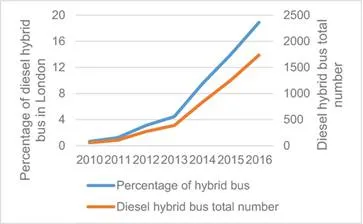
The impact of the deployment of the low
emission bus fleets has already begun to have an impact on emissions in London,
as shown in Figure 5. In the last few years, emissions of NOx and
CO2 have begun to drop due to the introduction of diesel hybrid
buses into the TfL fleet and the retrofitting of selective catalytic reduction
measures into the existing fleet. The level of PM100 emissions dropped
considerably due to the introduction of PM filters in the early 2000s. It is
expected that these will continue to drop as further deployment of diesel
hybrid and zero emissions vehicles continues.
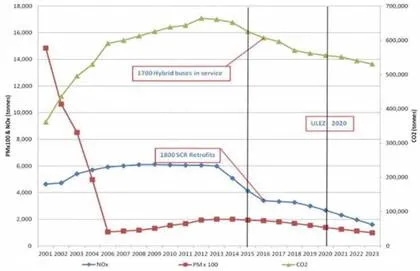
The performance of the diesel hybrid bus fleet in London is very variable, as might be expected due to differing models and routes. It was claimed that the average Euro V bus achieved a fuel economy of 32.9 l/100 km in London [9]. The reported fuel economy of diesel hybrid buses operating in London is presented in Table 1. As may be expected, the type of bus and bus route significantly affects the fuel economy, where a single decker bus generally exhibits a higher fuel economy than a double-decker bus. It was found that the introduction of diesel hybrid technology improved the fuel economy on nearly all routes; however, there were a couple of discrepancies to this, such as on the E8 bus route where the fuel economy actually decreased. The introduction of the new Routemaster bus appears to provide a slight improvement over previous diesel hybrid buses; however, there appears to be significant discrepancies between the recorded and expected performance. Results released by TfL in 2014 suggest a fuel economy in the range of 38.2–45.6 l/100 km, whereas it is claimed by the manufacturer that a fuel economy of 24.4 l/100 km was recorded on the 159 bus route. Unfortunately, the details for these results are not available and so it is difficult to determine the validity of the results. This discrepancy could be the result of a number of factors such as the route topology, traffic conditions, driving style and passenger conditions.
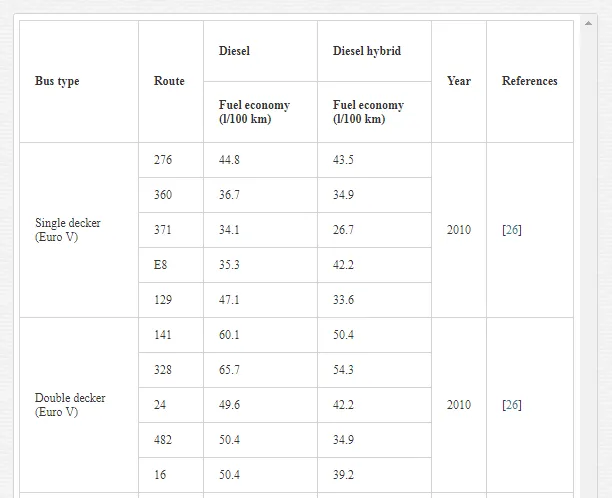
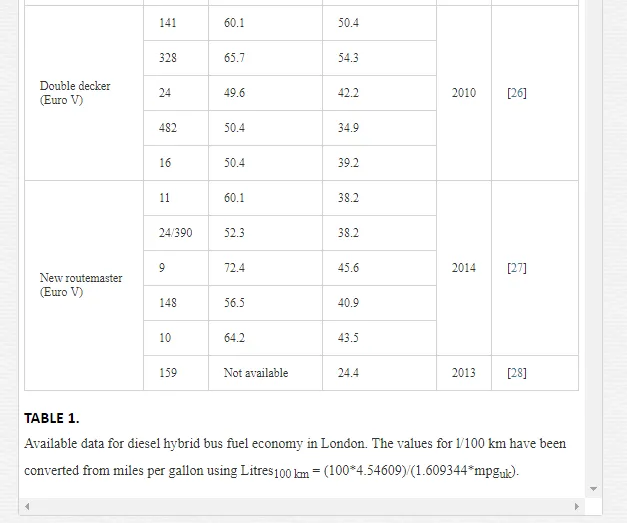
In summary, TfL has successfully introduced a large number of diesel hybrid buses into their bus fleet. This has resulted in a decrease in the emissions associated with the bus fleet, with considerable further reductions expected. It provides an example of the successful deployment of diesel hybrid buses into a large operational bus fleet to achieve reductions in emissions and fuel consumption. However, the increased cost and system complexity remain problematic.
Battery electric bus
OVERVIEW OF ELECTRIC BUSES TECHNOLOGY
The battery electric bus, often described as a pure electric bus, uses an electric motor for propulsion and a battery for energy storage [29]. In most cases the battery is the primary energy source, although for trolley buses power is delivered from overhead cables during operation.
The configuration for electric buses is typically fairly straightforward since it is basically a battery driving an electric motor to propel the vehicle [30], as shown in Figure 6. During braking it is also possible to make use of regenerative braking to recharge the battery during braking. The main battery technologies that have been used in transportation are Ni-MH, Zebra (Na-NiCL2) and lithium batteries [31]. The most promising of these are the lithium batteries, where three main categories exist, these being Li-ion, lithium polymer (LiPo) and Lithium-iron-phosphate (LiFePO4) batteries [32]. Most current buses use lithium-based batteries [33] due to their high power and energy densities and fast charging capabilities, although their high cost is still problematic [32]. A problem faced by all battery technologies is their cycle life; typically, these are short and hence require relatively regular replacement [34]. In addition to a battery pack, some buses utilise supercapacitors in conjunction with a battery as supercapacitors are much more effective in shielding batteries from high current load and thus increase battery life [35]; however, their low energy density means they are unsuitable to be used as the primary energy source, as shown in Figure 1. They do, however, have several key advantages over existing battery technologies, such as very high power densities and discharge rates as well as very long cycle life [34]. There is no simple answer to which battery technology is best, as it will depend on the application. Mahmoud et al. [36] carried out a detailed comparison study of different electric powertrains and concluded that a single technological choice would not satisfy the varied operational demands of transit services because electric buses are highly sensitive to the energy profile and operational demands. Electric buses are zero emission at the point of use and therefore offer great emission savings particularly in terms of local air pollution when compared to ICE or hybrid buses, as well as very high efficiency. However, there are a number of barriers to widespread deployment, the main ones are recharging time, vehicle range, infrastructure and cost [34].
Battery electric buses normally operate in one of two different forms: opportunity and overnight [32]. Opportunity e-buses have a smaller energy storage capacity that offers limited range but can be charged much quicker (5–10 minutes); while overnight e-buses have a much larger energy storage but at the cost of longer charging time (2–4 hour) [36]. These represent two different approaches for electric buses in the urban environment. The opportunity approach aims to minimise the weight of the battery pack by utilising frequent and fast recharging at points along the bus route, such as bus stops or the end of route [32]. This holds the promise of high efficiency and lower projected bus costs but requires a comprehensive recharging network [37]. Route flexibility of the bus is, however, limited, as it is required to follow the assigned bus route to recharge the battery. The overnight method utilises a large energy storage system to extend the range so that the bus can drive the entire route/day without recharging [37]. This holds the promise of greater route flexibility and convenience as well as utilising a centralised recharging infrastructure, but suffers from passenger loss due to increased battery weight as well as battery lifetime issues [38] and battery cost [34]. An alternative approach is offered by the Trolleybus, which has a small battery but receives power from overhead cables along the assigned route. This overcomes problems associated with range and recharging times but is very limited in terms of route flexibility.
The process of recharging a battery electric bus can be completed through plug-in (conductive), wireless (inductive) or catenary (overhead power lines) charging. Plug-in charging requires a direct connection through a power cord [39] and is well-suited to overnight bus charging, but can be used in some instances for opportunity charging. This is popular due to its simplicity and high efficiency [39]. Wireless charging relies on induction between two coils, this is better suited to opportunity buses where recharging can take place along the route without the need for a physical connection [39], such as the PRIMOVE bus where charging is carried out at each end of the route and at five intermediate stops [40]. This form of charging, however, suffers from increased charging times and relatively low efficiency [39]. The trolleybus uses overhead catenary to provide power to the bus [41]. This type of charging exhibits high efficiency but requires an extensive network of overhead cables.
Table 2 shows a selection of operating pure electric buses in different locations and utilise a number of battery technologies and operating approaches. In 2015, there were an estimated 150,000 battery electric buses, mostly located in China, with a sixfold increase between 2014 and 2015 [42]. The electric bus market is growing quickly where it had a 6% share of global bus purchases in 2012 but is forecasted to grow to 15% by 2020 [43]. Battery electric bus development has been carried out all over the world with the largest shares in China, Europe and North America [44]. It is clear that some of the buses listed in Table 2 utilise more than one mode of operation to provide for the operational power requirements, such as the complete coach works bus, which uses both overnight and opportunity charging. The differences in operating regimes are reflected in the sizing of the batteries and as a result the range of the buses, where they vary from 5.9 kWh for the trolleybus design to >300 kWh for overnight charging. This will have a significant impact in terms of the bus’s battery costs; however, the charging infrastructure for overnight charging does not need to be as comprehensive as for the alternative methods.
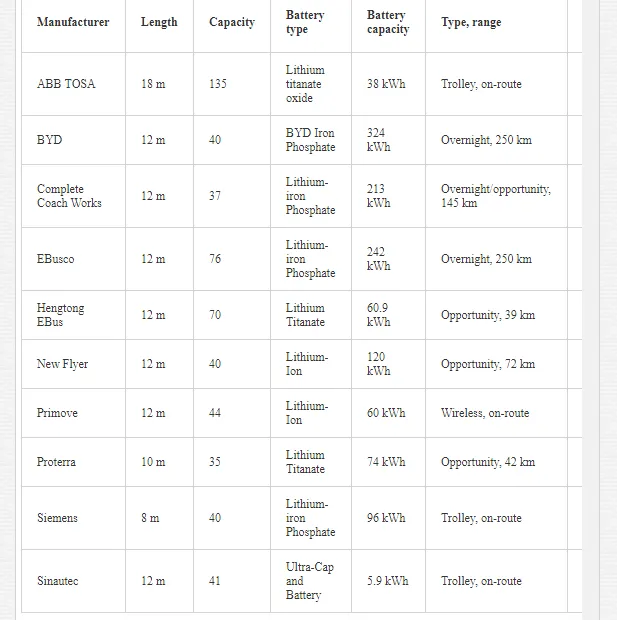
CASE STUDY: LONDON ELECTRIC BUSES
London has been working on overnight e-bus demonstrations since 2012 and is also investigating the potential of opportunity e-bus technologies. From the overnight e-bus perspective, TfL has collaborated with BYD, which is one of the largest electric bus manufacturer in China, to test the potential of battery electric buses in London, starting from 2012 [45]. The first two battery electric buses were handed over to TfL in 2013 and then entered daily service on two central London routes, numbers 507 and 521, which were the first battery electric buses in London. These single-decker 12-metre BYD buses utilise Lithium-Iron-phosphate batteries and have demonstrated a range in excess of 250 km on a single charge in real world urban driving conditions [46]. The 507 and 521 bus routes are relatively short commuter service routes and were chosen so that the bus can start operating in the morning peak alongside the diesel bus fleet and return to the depot to recharge during the day before resuming service for the evening peak [34, 47]. The battery takes 4–5 hours to recharge when fully discharged and has been designed for a cycle life of more than 4000 cycles, meaning a 10-year battery lifetime under normal operating conditions [48]. The trail fleet was extended to six buses in the summer of 2014. The trail buses in London not only provide a zero emission environmental benefit but also have shown promising result in terms of both technical and economic performance, and hence TfL has taken further steps towards adopting this new clean technology in the capital. The development timeline and future plans for London electric buses are plotted in Figure 7

The latest data in 2016 showed that there are currently 22 battery electric buses operating in London including 17 single-decker battery electric buses and five double-decker battery electric buses. This is a world first for double-decker battery electric buses, as shown in Figure 8, and entered service in May 2016. These are 10.2 m buses with a capacity of 81 passengers and a claimed range of 303 km. The battery is a Lithium-Iron-Phosphate battery with a capacity of 320 kWh [49]. They utilise a combination of both overnight and opportunity e-bus technology and will operate on route 69 in Central London. They will use a high powered wireless inductive charging system to top up their battery system at the beginning and end of this route to keep the bus operating throughout the entire day [50]. The recent double-decker electric buses have used wireless charging technology as part of innovative charging technology development. However, this is still far from a mature technology and requires a massive recharging infrastructure network [51]. The electric buses in London have shown promising performance on short commuter routes; however, pure e-buses are still best suited for shorter routes with operational flexibility and scope to recharge them in inter-peak periods due to the limit of present battery capacity and recharging technology [52].
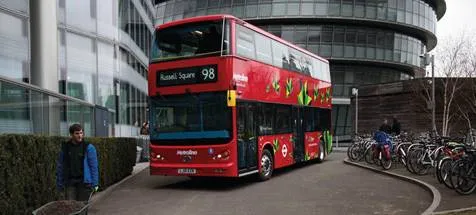
In 2015, BYD and Alexander Dennis (ADL) announced a partnership to provide 51 further single-decker buses to route operator Go-Ahead with an expected delivery in late 2016 [53]. BYD will provide the batteries and electric chassis technology, and ADL will provide the bus body-building technology [54]. The cost of each bus is expected to be £350,000 [55].
In summary, the recent development and deployment of battery electric buses in London have shown that electric buses are technically feasible. It can be seen that electric buses will also have an important role to play in the coming ULEZ implementation in 2020. However, more time is needed to evaluate the actual performance and address the key challenges facing electric buses such as limitations of battery technology that restricts range.
Hydrogen fuel cell hybrid bus
BASIC THEORY
Hydrogen fuel cells (FCs) are considered a clean energy source with the main benefits over ICEs of zero harmful emissions during operation and high efficiency [56]. Although many types of FCs exist, this paper will only consider the application of FCs in transportation, considering the operating temperature, start-up time and technology maturity, Proton Exchange Membrane Fuel Cell (PEMFC) offer most promising solution [57]. Significant research into solid oxide fuel cells (SOFCs) in transportation has been carried out [58–60], although these have yet to been applied in real world bus applications. A PEM FC uses hydrogen as the fuel, which, through an electrochemical reaction with oxygen (usually from air) generates electricity with water as the only by-product from the chemical process [61]. By replacing the internal combustion engine in conventional buses, FCs can be used as the primary energy source to power a bus with electrical energy, therefore, achieving zero operating emissions. An additional advantage over ICE’s comes from the higher efficiencies exhibited by FCs [62, 63]. However, there are a number of barriers that need to be overcome before widespread deployment can be achieved. These are primarily cost and infrastructure [64, 65]. FC powered buses cost approximately five times more than a conventional diesel bus with the similar power output [66], where they typically cost in excess of £1,000,000 [67], due primarily to the expensive FC stack and the small scale of production [68]. In addition, the widespread deployment of FC buses would require a significant investment in hydrogen refuelling infrastructure [64]. The implementation of FC buses has shown that the technology is a promising solution for zero emissions buses if these barriers can be overcome.
Figure 9 shows the configuration usually used in FC vehicles. The basic drive train utilises a FC to power the propulsion motor; however, FCs are not well suited to providing for the transient power demands associated with city driving buses [69–73]. As such, most FC buses utilise a form of energy storage in a series configuration to both address this and also to utilise regenerative braking [74]. An additional benefit of such an approach is that the size of the expensive fuel cell stack can be reduced [75]. The energy storage implemented is usually either electrochemical battery technology such as Li-ion or NiCd batteries or electrostatic supercapacitors (sometimes referred to as ultracapacitors). The choice between these depends on the particular design and requirements of the system, with batteries offering reasonable power and energy densities although they have a relatively short cycle life and supercapacitors offering poor energy densities but excellent power densities, as shown in Figure 1. Additionally, supercapacitors have very long lifetimes of up to 40 years [31].
In a series configuration, there are three main modes of operation that can be utilised to provide for the buses power demands, as shown in Figure 10. Although these are the main modes of operation, the way these modes are utilised will depend on the control strategy implemented [76].

· Mode 1: The SC discharges to supplement the FC to provide for high transient power demands. This type of operation is expected to occur under heavy loads such as during acceleration or going uphill.
· Mode 2: The FC will both power the load and use excess power to charge the SC. This is expected to occur under low loads, when the FC power output is higher than the required load.
· Mode 3: The power from the FC and generated power from regenerative brake will both be used to charge the SC. This is only expected to occur when the drive motor is operating as a generator in the regenerative brake mode.
There have been a number of projects aimed at utilising FC technology for bus propulsion applications. Table 3 lists many of the projects currently in operation along with the FC size and energy storage used. The projects are split into two main categories depending on the relative size of the FC and energy storage systems. The majority of the current projects are FC dominant, whereby the FC is expected to provide for the majority of the propulsion needs. Alternatively there a few examples of battery dominant hybrids, where the battery is the main source of power with the FC used as a supplementary power source. It was announced in 2017 that the JIVE project is to implement 142 buses across nine European cities with 56 new FC buses in the UK, which will be the first large scale validation project of FC bus fleets [78].
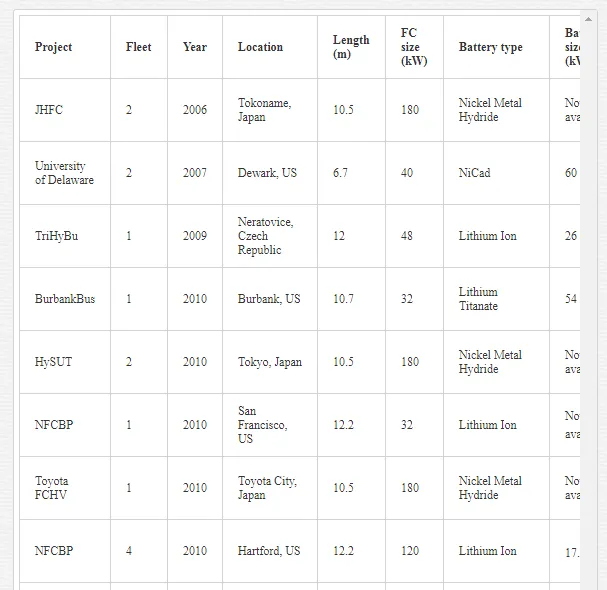

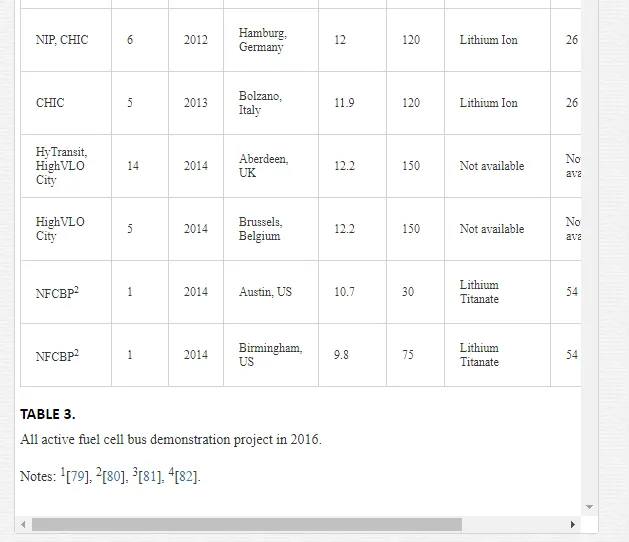
CASE STUDY: TFL FC BUS ON THE RV1 BUS ROUTE
London has been involved with the testing and deployment of FC buses, Figure 11 shows the evolution of FC bus implementation in London. Initially, this was through the EU funded Clean Urban Transport for Europe (CUTE) project, which aimed at introducing hydrogen FC buses into European cities, where a test run of three buses were operated on the RV1 bus route between 2004 and 2006, this was increased to five buses from 2007 to 2009 [83]. London is now part of Clean Hydrogen in European Cities (CHICs) project with the first deployment in full service of the next generation of FC bus in 2011 and is expected to continue until 2019. There are currently eight Hydrogen buses operating in Central London as part of the CHIC project, fully covering the RV1 bus route, which is 9.7 km in length [83]. It is expected that by 2017 a further two buses developed as part of the 3Emotion project will be deployed through Van Hool [84]. The buses operate for 16–18 hours/day, before returning to the depot for refuelling at the central depot, which takes <10 minutes [85]. The workshop, which is responsible for routine maintenances and hydrogen management, was specifically designed and built for hydrogen FC buses [86]. The hydrogen has been transported in liquid form to the depot and converted into gaseous form to refuel buses [83], it is then stored on site in gaseous form at 500 bar [86].

The buses themselves have developed throughout this project, where the first generation was powered only by a FC. These utilised a 250 kW fuel cell [82] and achieved a hydrogen economy of 18.4–29.1 kg H2/100 km [87]. The buses deployed as part of the CHIC project utilised a series hybrid configuration, with a 75 kW PEM FC from Ballard and a 0.5 kWh Bluways supercapacitor energy storage system [88]. This introduction of the hybrid system significantly reduced the hydrogen economy to <10 kg H2/100 km [87] and is one of the most significant results of the CHIC project in London. Figure 12 shows that the fuel economy of the buses operated as part of the CHIC project showed considerable improvements over those in the CUTE project. It can also be seen that the London buses performed better than the CHIC target, exceeding it by nearly 50%. For all of the London FC buses, the hydrogen is stored as a compressed gas at 350 bar, with the gas cylinders stored on the roof of the bus [82].

Between 2011 and 2016, the FC buses in operation in London have covered over 1.1 million kilometres [89], and a number of the FC buses have achieved the milestone of 20,000 hours of operation [90]. This reflects the improvement of availability seen over the course of the deployment of CHIC’s London fleet. Figure 13 shows the availability from January 2012 until May 2015. The monthly availability of London FC buses has also significantly increased after the availability upgrade program carried out in 2014. The availability is expected to improve to over 85% by the end of the CHIC project as operators gain more operational and problem-solving experience.

Apart from the technical and economic improvements, the London trail buses have also proven that the technology became more viable because of the full working schedule, direct diesel replacement, centralised infrastructure and high public acceptance [86]. The trial test of FC-powered buses projects has provided promising performance as a long-term solution to zero emission transportation.
Comparison study
This part aims at to provide a comparison of the current state of low emission and zero emission bus systems. Diesel hybrid buses have been developed and deployed as a means of achieving emissions reductions, where a number of advantages in terms of efficiency, emissions and fuel consumption can be seen over diesel buses. There are, however, a number of problems associated with their widespread deployment. The first of these is the cost and is due to the additional components necessary for the electrical system. Second, the inclusion of the electrical system necessitates a significantly more complicated configuration [19]. Third, although diesel hybrid buses can offer significant improvements in terms of CO2 and NOx emissions, the primary energy source is still the ICE. As such, they fail to address the underlying source of emissions and are therefore fundamentally limited in the improvements that can be achieved. As such, they can only really be considered as a transitional technology to reduce emissions but are not a viable option for meeting zero emissions targets. In order to meet the requirements for zero emissions buses, which is the ultimate objective for a clean transportation network, technologies such as electric and FC buses have been developed as a long term solution for city bus transportation needs. Therefore, this section will mainly compare the battery electric bus (opportunity, overnight and trolley) and FC bus technologies as the two most promising zero emission solutions in terms of the operational requirements and is summarised in Table 4. The rankings are based on the authors’ opinions with reasoning given in the paragraphs below.
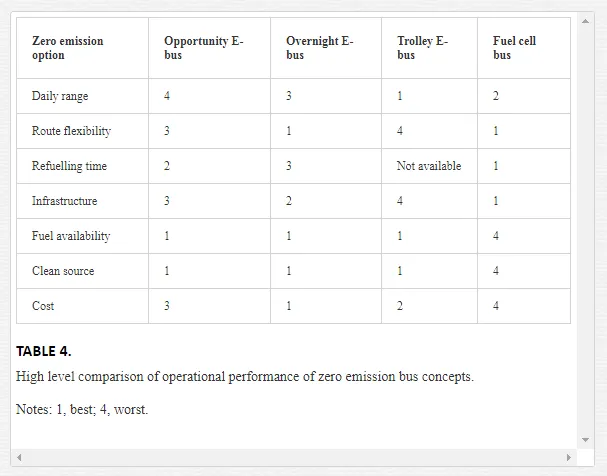
Range: Opportunity e-buses have a smaller energy storage that requires frequent recharging, which equates to poor performance in terms of daily range. Overnight e-buses utilise a much larger battery, which increases the range with reported values of over 300 km per charge. Trolley e-buses are continuously powered with electricity by overhead lines along the route which effectively gives unlimited range. FC buses use hydrogen cylinders as the fuel tanks, which allow the range to be greatly extended (up to 450 km) for as much as hydrogen fuel cylinder weight and size allows [91].
Route flexibility: Opportunity and trolley e-buses require recharging infrastructures along the route which greatly limits their route flexibility. This is somewhat dependant on the size of the on-board battery and will likely be more acute for trolley e-buses. The overnight e-buses and FC buses are expected to be able to operate for an entire day’s service without recharging or refuelling. As such this allows for much greater route flexibility. This appears to be easily achieved for FC buses, however for overnight e-buses this is not always the case and will again be dependent on the size of the battery.
Refuelling time: Opportunity e-buses require frequent recharging throughout the entire route. Although each recharges for the opportunity e-bus only takes up to 15 minutes, it is still considered as a drawback due to the requirement for regular recharging. Overnight e-buses require a longer recharging time (average >4 hours) after each operation due to the increased battery capacity. The recharging time is heavily dependent on the charging power. Trolley e-buses are charged through overhead wires so that they require no refuelling time. FC buses are refuelled with gaseous hydrogen, which can be completed quickly (<10 minutes) [91].
Infrastructure: Opportunity e-buses and trolley buses require corresponding infrastructure along the route and each end of the routes. Therefore, opportunity e-buses and trolley buses require a comprehensive infrastructure network. Overnight e-buses and FC buses both require infrastructure to recharge/refuel at the end of daily operation. This can, however, be centralised at the service depot and hence does not need to be as comprehensive. It appears, however, that the current recharging times for overnight e-buses presents a problem since it is likely that a significant number of recharging points and a massive recharging power would be needed to recharge the batteries of a large fleet in time for the next day’s service. This could potentially be an issue for the electrical grid infrastructure if the number of buses grows significantly, while this would not be a problem for FC buses because of their short refuelling time.
Fuel availability: All three battery electric bus technologies use electricity to recharge their batteries. This electricity could be central managed and distributed locally through the local electricity grids; however, widespread electric bus deployment could significantly stress this infrastructure. FC buses will likely require the development of a comprehensive distribution network for hydrogen, although on-site hydrogen production has been demonstrated. Additionally, hydrogen fuel storage would also create additional cost.
Clean source: Real zero emissions bus technology needs to be clean throughout the manufacturing process, fuel production and bus operation. Currently, battery electric and FC bus technologies can achieve zero operating emission but the lifetime emissions are much harder to quantify. It is hard to forecast how the emissions from new technology manufacturing will change, but the fuel production method can be roughly estimated. In the UK, the GHG emissions for electrical energy were 0.44932 kgCO2/kWh in 2014 [92]. This is likely to change as the UK’s energy mix changes, where in 2015, 24.6% of electricity was generated from renewable energy sources [93]. Similarly, for FC buses, the source of hydrogen is critical in determining the overall emissions. Currently, about 96% of hydrogen is derived from fossil fuels [94] which results in 13.7 kgCO2/kgH2 [95]. Despite this, investigations into the use of renewable energy for hydrogen production through the process of electrolysis have been carried out offering potential for a low carbon source of hydrogen. Currently, electricity for battery electric buses is a cleaner fuel than hydrogen for FC buses.
Cost: Both electric and FC buses have higher capital costs than a conventional diesel bus; however, FC buses are currently far more expensive than electric buses. The capital cost of electric buses is somewhat dependant on the type of operation expected, where overnight buses will have higher costs than opportunity and trolley buses due to the increased battery capacity. This does, however, need to be weighed up against the cost of infrastructure, where opportunity and trolley buses require a comprehensive and expensive charging network. Overnight electric and FC buses on the other hand can make use of a centralised recharging/refuelling infrastructure.
Throughout this chapter, the main technologies being implemented to meet the low emissions requirements have been presented. The most promising for these in terms of zero emissions are electric and FC buses; however, it is clear that there are still significant barriers to their widespread implementation. Following on from the challenges identified in the comparison section a number of challenges for future developments have been identified.
For electric buses, it is clear that further improvements to battery technology are required in terms of their energy densities and lifetime as well as the development of an effective charging infrastructure. The challenges are somewhat dependant on whether the bus is intended to use the overnight or opportunity charging schemes. For overnight charging, the charging infrastructure can be centralised; however, this necessitates very large power requirements for the charging infrastructure, additionally the range of the buses needs to be addressed through battery developments. The opportunity charging schemes a comprehensive and distributed charging network. In most cases, this requires the development of high efficiency and power wireless charging technologies.
The future development of FC buses requires development in a broader range of areas. This includes further work on individual components such as the FC stack and hydrogen storage. The FC stack is still the most expensive component of the FC bus. The further development of the control strategies for hybridised buses held significant promise in reducing the size of the required FC stack and improving the fuel economy. Hydrogen storage is a key area for future research for bus applications, where technologies such as solid state storage offer potential to improve the storage density of hydrogen. For widespread implementation, the development of the hydrogen infrastructure is vital. This includes the production of hydrogen, particularly from clean sources, the distribution of hydrogen or on-site production and purification.
